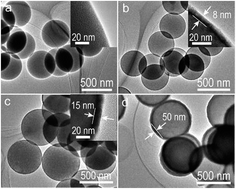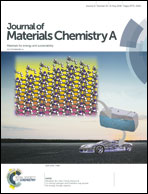Construction of uniform transition-metal phosphate nanoshells and their potential for improving Li-ion battery performance†
Abstract
The construction of uniform core–shell nanostructures using transition-metal phosphates as the shell has been a long-standing challenge in the field of nanotechnology. Due to their extremely low solubility constants, metal phosphates are prone to precipitate independently in solution, making a heterogeneous growth around the preexisting seeds extremely hard to achieve. Here, we demonstrated that it is possible to overcome the hurdles arising from their intrinsic growth habit, and form uniform metal phosphate nanoshells with their thickness tuned with nanometer accuracy. Particularly, for the formation of different nanoshells including Ni3(PO4)2, Co3(PO4)2, and Mn3(PO4)2, it has been found that a cooperative effort to control both the solvent environment and the precipitating agent is critical to tuning the growth kinetics of these metal phosphates, making it convenient for us to grow uniform nanoshells around a large variety of seeds. The application of this synthetic protocol for the surface treatment of LiNi0.5Mn1.5O4, a well-known high voltage cathode material in lithium ion batteries, demonstrates that a 4 nm coating layer of Co3(PO4)2 can be achieved as a protective shell, which provides a much improved cycling stability to the electrode and holds promising potential for its application as a high energy cathode.



 Please wait while we load your content...
Please wait while we load your content...